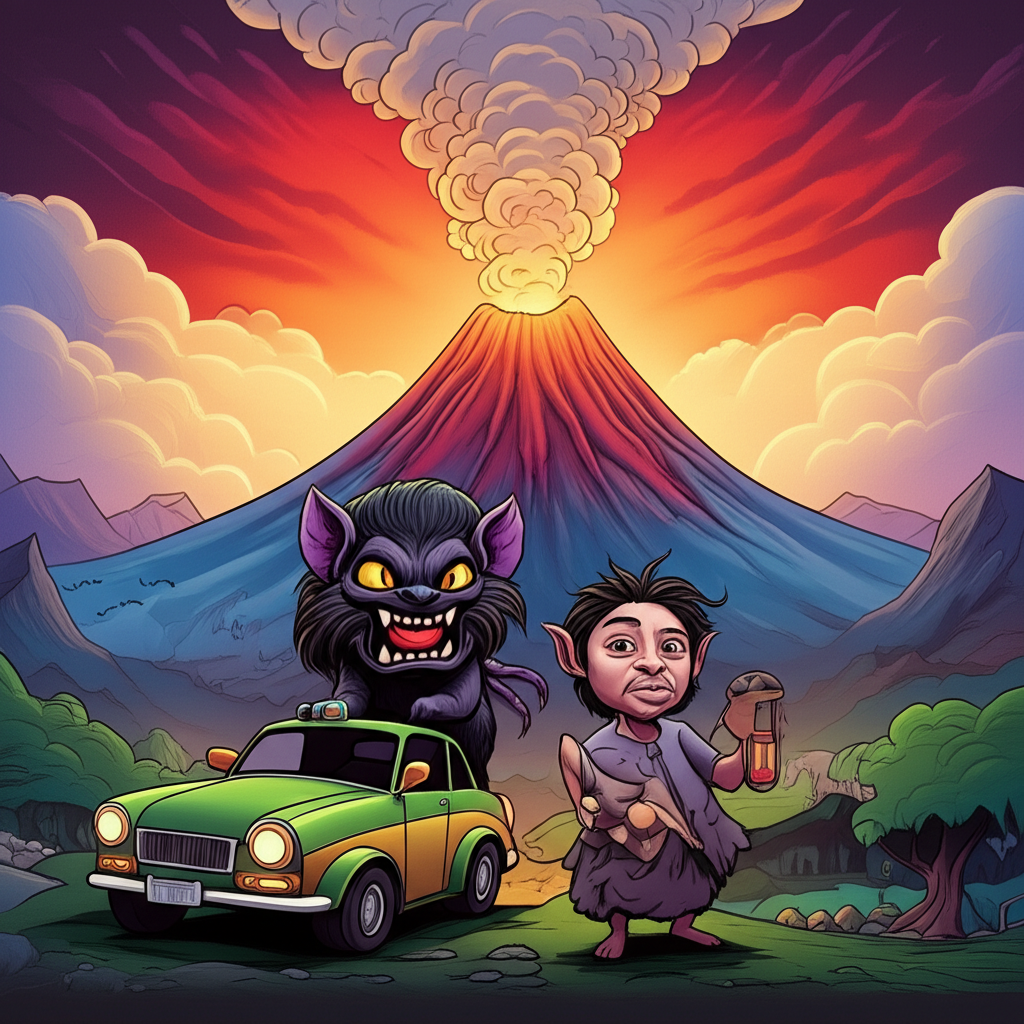
The vast and intricate tapestry of human culture is woven with threads of myth and legend, stories passed down through generations that attempt to explain the world and our place within it. From the earliest stirrings of human consciousness, people have looked to the celestial bodies and the natural phenomena around them, crafting narratives to make sense of the awe-inspiring and the terrifying. Among the rich folklore of the Philippines, particularly among the Visayan people, lies a captivating tale: that of Anitun Tabu and the ancient war between the colossal serpent, Bakunawa, and the radiant Moon. This is not a chronicle of historical events or divine pronouncements, but rather a window into the imaginative world of ancient peoples, a testament to their understanding of the cosmos and the forces they perceived to be at play.
The genesis of this myth can be traced back to a time when the world was perceived as a more intimate and enchanted place. Imagine a society deeply connected to the rhythms of nature, where the cycles of the sun and moon dictated daily life, and the vastness of the ocean and the mystery of the night sky held profound significance. The ancient Visayan people, inhabiting the archipelago’s verdant islands, lived in close proximity to both the sea and the stars. Their world was one of lush rainforests, vibrant coral reefs, and an unending horizon. In this environment, where the elements held immense power and the unseen often felt palpable, their worldview was likely animistic. They might have believed that spirits inhabited natural objects – the wind, the rivers, the trees, and yes, even the celestial bodies. The moon, a constant presence in the night, waxing and waning, a silent observer of human life, would have been a focal point for their wonder and their fear.
Central to this legend is Bakunawa, a creature of immense power and terrifying beauty. In the oral traditions, Bakunawa is often described as a colossal serpent, a sea dragon with scales that shimmered like the depths of the ocean and eyes that held the cold glint of a starless night. It was a creature of the abyssal plains, a denizen of the unknown beneath the waves. Its immense size was said to be capable of swallowing islands, and its breath could stir the most tempestuous of storms. Symbolically, Bakunawa represented the primal forces of chaos and destruction that lay hidden beneath the surface of the world. It embodied the terrifying power of the unknown, the vastness of the ocean’s depths that humans could not fully comprehend, and the destructive potential that lurked in the shadows. It was a creature that evoked primal fear, a representation of the untamed and the unpredictable.
The narrative of the War of Bakunawa and the Moon unfolds as a celestial drama, a cosmic struggle for dominance. According to the legend, Bakunawa, driven by an insatiable hunger or perhaps a desire to plunge the world into eternal darkness, would periodically emerge from its underwater lair to devour the Moon. The act of devouring the Moon was not a simple act of consumption; it was an attempt to extinguish its light, to steal its celestial radiance and plunge the world into a terrifying, unending night. The ancient Visayans would witness the Moon seemingly disappear, a phenomenon we now understand as a lunar eclipse. To them, this was Bakunawa at work, its monstrous jaws closing around their celestial guide.
In this time of impending darkness, the figure of Anitun Tabu emerges. While the precise depiction of Anitun Tabu can vary in different retellings, she is often portrayed as a powerful benevolent entity, a guardian of the sky, or even a specific deity associated with the wind or the heavens. Some accounts describe her as a beautiful maiden who wielded the power of the wind, capable of summoning gusts strong enough to dislodge even the mightiest of creatures. Others see her as a protector of the Moon, intervening when Bakunawa threatened to consume it. The crucial element is her role as a counterforce, a being that rallied against the encroaching darkness.
When Bakunawa would ascend to swallow the Moon, the people, guided by the elders and their understanding of the myth, would engage in their own form of intervention. They would gather, their voices rising in a cacophony of shouts, banging pots and pans, and beating drums. This was their way of aiding Anitun Tabu, of scaring away the monstrous serpent. The din was intended to disturb Bakunawa, to make its grip on the Moon precarious, and to encourage Anitun Tabu to unleash her full might. The legend suggests that the combined efforts of Anitun Tabu and the desperate cries of humanity were often enough to make Bakunawa recoil, to release its celestial prize. The Moon, bruised but unbroken, would then slowly reappear, its light returning to the world, a symbol of hope and resilience.
The symbolism embedded within this myth is rich and multifaceted. Bakunawa’s attempts to devour the Moon can be interpreted as a representation of humanity’s struggle against the forces of chaos, ignorance, and the unknown. The Moon itself, in its ethereal glow, could symbolize order, knowledge, and the guiding light that illuminates the darkness. Anitun Tabu, as the protector, might represent the inherent goodness and protective forces that exist in the universe, or perhaps the collective will of humanity to resist overwhelming darkness. The lunar eclipse, a celestial event that would have been deeply unsettling, was thus reframed as a cosmic battle, a narrative that provided a sense of agency and understanding in the face of the inexplicable. It was a way for people to explain a frightening phenomenon and to feel empowered to influence its outcome through collective action.
In the modern era, the myth of Anitun Tabu and the War of Bakunawa and the Moon continues to resonate, albeit in different forms. While no longer taken as a literal account of celestial events, these stories are cherished as vital elements of Filipino cultural heritage. They find expression in contemporary literature, where authors weave these ancient tales into fantasy novels and children’s stories, introducing new generations to the rich tapestry of their ancestral folklore. In visual arts and popular culture, Bakunawa has become a popular motif, appearing in films, animations, and video games, often depicted as a formidable dragon or sea monster, a testament to its enduring power as an imaginative entity. Cultural studies scholars analyze these myths to understand the historical context, societal values, and worldview of ancient Filipinos.
It is crucial to reiterate that the story of Anitun Tabu and the War of Bakunawa and the Moon is a traditional narrative, a product of human imagination and a desire to comprehend the universe. It is not a literal truth, nor is it a belief system to be adopted. As Muslims, we recognize that the ultimate Creator and Sustainer of all existence is Allah (SWT), and that all power and creation originate from Him alone. This myth, however, serves as a valuable cultural artifact, offering us insights into the ingenuity, the fears, and the hopes of our ancestors. It is a reminder of the enduring power of storytelling, the way in which ancient peoples used their imaginations to navigate the mysteries of their world, and how these narratives continue to enrich our understanding of cultural heritage and the boundless capacity of the human mind to create enduring tales. The whispers of the sky serpent and the brave defense of the Moon remain a vibrant thread in the rich tapestry of Filipino folklore, a testament to the power of stories to connect us to our past and to inspire our present.





